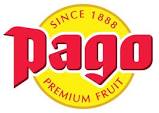Pago (brand name)
| PAGO International Gesellschaft mbH
|
|
|---|---|
| legal form | GmbH |
| founding | 1888 |
| Seat | Saint Florian near Linz |
| Branch | Food |
| Website | www.pago.at |
Pago is an international fruit juice brand from the Eckes-Granini Group . It was founded in 1888 as a company by the brothers Franz and Jakob Pagitz.
history
The company was founded in Klagenfurt in 1888 by Jakob Pagitz senior and initially produced soda water . In 1900, for the first time, soda water was mixed with apple juice and currant juice to make lemonade and brought onto the market as specials and crackers . From 1920 Jakob Pagitz junior worked in his father's business (according to other sources, he took over the business in 1920). Below him was built from 1928 Süßmosterei , in 1930 began the sale of commercial air Süßmost.
In 1930 the production of pure fruit juices began, which were marketed under the name Liquid Fruit . The current brand name Pago dates back to 1949 and comes from Pag itz and O bst and was registered in October 1949 at the Austrian Patent Office .
While the drinks were originally only sold in the area, the company initially expanded sales to Vienna . As a result, distribution centers were set up in all major cities, such as Vienna, Salzburg and Graz . At the end of the 1950s, Pago was then sold throughout Austria, and from 1960 Pago is represented as a brand throughout Austria . After the death of Jakob Pagitz junior in 1964, the family business is continued by his wife Hilde and his three children Gertraud, Jakob Heinz and Heidemarie in the limited partnership founded as Pago KG .
In 1968 the foundation stone was laid at the site in Schrödingerstraße on the southern outskirts of Klagenfurt. In 1970 the company was able to move to the new plant with the larger concentration systems for fruit juice production and with more modern logistics. In 1977 Pago's range reached 70 types of fruit juices.
In December 1977 a company was founded in which Brau Beteiligungs AG took over a 60% share. In 1978/79 the company was converted and Pago became 100% owned by the Brau Union.
At the beginning of the 1980s, sales through the food trade began for the first time. In 1984 the company was awarded the national coat of arms . Internationalization began in 1988. In 1989 the figurative mark was created with the green glass bottle, the unmistakable label and the yellow lid, both with the red Pago lettering. Also from 1989 Pago positioned itself with the sales channel hotels, restaurants and cafes in Italy. The decade of the 1990s was characterized by the international expansion of sales and new container sizes.
From the 2000s, own sales companies were founded in larger countries. With the expansion of the EU in 2004, Pago also expanded its sales to Eastern European countries. One began to enter into cooperations with spirits producers for the so-called mixing concept of mixing Pago fruit juices in cocktails. In 2005, Pago introduced PET bottles and redesigned the Pago drinking glass. In 2006, the Pago range was expanded to include Pago Spritzt , which is available in four flavors and filled in PET bottles. With Pago Spritzt , Pago went back to the roots of 1900, when fruit juices mixed with soda water were brought onto the market for Kracherl or Spezi . In 2007 the Pago logo was relaunched and has been in use since January 1, 2008. In 2008 a new 0.5 liter glass similar to the previous 0.2 liter glass was introduced.
At the end of 2012, Brau Union Österreich AG sold Pago to Eckes-Granini . Since the purchase of the brand, work has been carried out to integrate Pago into the group of companies. The headquarters of Pago moved from Klagenfurt to St. Florian in Upper Austria, the headquarters of Eckes-Granini Austria. Strategically important partnerships, such as with the beverage bottler "Kärntnerfrucht", were established and the bottles for Eckes-Granini Austria are still filled in Klagenfurt today.
Web links
- Pago website
- Carinthian fruit in the RegiowikiAT
Individual evidence
- ↑ a b Pago Austria - About us. Retrieved November 15, 2017 .
- ↑ Brau Union sells Pago to Granini Group on ORF on December 18, 2012, accessed on December 18, 2012
